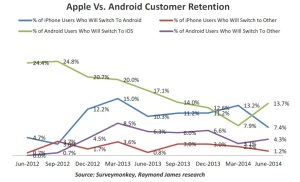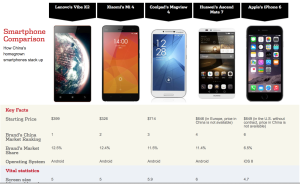Technology companies have dominated the business world of today through means of innovation and creativity. Technology allows us to make the world a smaller place and connect individuals from different ends of the world. On October 10th 2014, Apple announced their new iPhone 6 and iWatch. The biggest shock to the industry was the drastic increase of the screen size for the new iPhone. Apple had officially entered the phablet, phone/tablet market.
The single product the sky rocketed Apple to the top of the tech industry was its sale of the iPod, an improved version of the Walkman. Making the already invented mobile music playing device much smaller, more user friendly, and look nicer allowed Apple to truly sell a great product. Then Apple announced its first iPhone. The innovative feature of this groundbreaking technology: multitouch screen. In 1992 the IBM Simon was launched as the first touch screen phone but it was not very successful. Apple took that idea, refined and made it look sexy for consumers. In your hand you held the power of the internet with a single swipe of your finger, everyone had to have it. More compatible products were created, Macbook, iMac, iPod Touch, iPad, iCloud, etc. While Apple has established itself as one of the most successful mobile device providers, Google quickly stepped in to introduce its mobile software called Android.
There is unanimous agreement that Android has currently overtaken IOS as the most popular operating system on a mobile device in the U.S. and globally. According to the latest data from Kantar Worldpanel ComTech, “Android now holds 61.9% of the U.S. market share to Apple’s 32.5%.” Internationally, the numbers reflect a similar trend with Android having 82.7%market shares in China and 73.3% in other European countries. However even with this drastic market share difference, Apple has not cared about its dominance in this specific sector for a long time.
Apple still makes more money that all of the Android devices combined. Today, Apple’s biggest competitor is Samsung. Other smartphone companies such as HTC, LG, Motorola, Nokia, and Blackberry are all losing money. Samsung is the only other phone company right now other than Apple that is making money. Even so, Android does not sell more apps and does not generate more ad revenue than Apple. Companies will invest more money in Apple because it provides more real world usage data and Apple has an overwhelming share of smart phones and phablet app sales, web browser use, and ad network units. Additionally, the people who have recently joined the Android family are not Apple’s intended audience. This individuals buy the “junk phones” from companies like LG and HTC that do indeed operate on an Android system, however these individuals would not have bought an iPhone instead. With the dominant market share, Apple still makes more money because its target is the 15% of the top richest population in the world. But how exactly does Apple make money?
Apple sells, phones, computers, music players, but most importantly, it sells an idea: simplicity. Upon turning on the iPhone for the first time, the user quickly understands that to unlock the phone you must swipe your finger to the right. Without any instruction manual or video tutorial, any individual can figure out the basics to how to use an iPhone because the phone is very intuitive. Apple stands for simplicity and automation. Once an individual buys an iPhone, he or she is going to want to buy a Macbook to integrate the two systems, then an iPad for a more mobile form of the Macbook and finally purchase the iCloud to sync all of the data together across all platforms; this is just one person, now imagine a whole household. The wife needs a phone, the kids both need a phone, all of them buys apps on the apps store and to hold everyone’s data on the iCloud you need to buy more space. With one purchase of the iPhone you have now entered the uniform family plan of Apple, simplicity and automation at its best. Not everyone can afford this, but the people that can will buy everything and the newer versions of each product. Apple does not need to reach the 61.9% market share of Android, it only needs to cater to the 15% of the richest people in the world. Apple was king at holding this market down, however in the pas few years, Samsung has invaded with tremendous force and speed into the smartphone market. Samsung is Apple’s biggest competitor.
Samsung has thousands of technology patents and many companies have infringed on then, however they strategically chose not to pursue them in court. If Samsung does infringe on another companies patent and the other company chooses to sue them, the chance of the other company having previously infringed on their patents is fairly high. This exact situation occurred with Apple on patent infringement for multiple devices. Samsung quickly responded and counter sued and the war between the two giant tech companies began. After about a year of war, through trials and appeals, apple won and was awarded $930 million in damages. However, during this war, Samsung managed to take a portion of Apple’s smartphone market share. Samsun started as a fish and product exporting business and later entered the technological space of selling black-and-white televisions. Samnsung has a reputation of selling cheaper knock off brands and inferior products, but many people still bought their products because it was more affordable. Initially the smartphone market was no different.
The first major smartphone that set Samsung apart from other junk phone distributors was the Galaxy S. It first launched in Singapore on June 4 2010 and after the first weekend, Samsung had announced that the Galaxy S had sold out with the exclusive Samsung phone carrier in Singapore. The Galaxy series phone has drastically improved on the past model with each new version. Within the past 2 years, many iPhone users switched over to the Galaxy S4 and S5 simply because it had a bigger screen than the iPhone. Samsung had established itself as the leading player in the phablet market.
Steve Jobs was the face of Apple, he sold the idea of simplicity and automation to the general public. One of the biggest selling points at Steve Job’s key note speech for the first iPhone was the size, “it’s a phone that fits comfortably in your palm at 3.5 inches.” When the iPhone 5 was announced with the specs of a bigger screen, Apple quickly released a short 30 second commercial addressing the issue. Here is the video:
With the lost of smartphone market share to Samsung, Apple quickly realized that its user were switching over to Samsung for a bigger screen. Regardless of the message of Steve Jobs, they disregarded his message to win back their previous users. The age of the phablet has come and Apple’s transition into a larger screen confirms the change. All of the giant tech companies have entered the phablet market and competition will continue. Google and Apple have also had patent wars in the past but have agreed to drop all cases to focuses on creating better products. With this shift in focus, consumers can expect to see better products coming out in the near future. Apple learned from its war with Samsung that legal battles may result in a monetary gain mandated from the court, however, market share is dictated by how good of a product the companies can create. This is how a free market should be.
In preparation for its phablet unveiling, Apple released a guide on how Android users can easily import their media from their computer into iTunes to switch over to the iPhone 6. http://support.apple.com/kb/HT6407?viewlocale=en_US&locale=en_US
The opinions on preference between the two smartphones are split about evenly. However, interestingly enough, Gazelle, a tech-reviewing site that frequently analyzes the smart phone market, revealed that their trade-ins from the iPhone 6 to the Android tripled in the past week before the iPhone 6 launched.

SuperSaf TV on YouTube sums up the opinions on preference fairly well in his comparison review. He says, “Depends on what your preference is, do you prefer something with expandable storage, removable battery, and water and dust resistant or do you want something that looks and feels that much more premium.” The iPhone is branded as the stylish, sleek, and simple phone that makes your life a lot simpler, while the Galaxy S5 is branded as the highly customizable, more complicated and sophisticated phone that may appeal more to technology savvy individuals. Regardless of the preference between the two phone everyone agrees that the launch of the iPhone 6 has had a global effect. Apple’s dominance as a tech giant has been felt all the way over in China and Taiwan.
China and Taiwan make up the two biggest manufactures of parts for the iPhone 6. When the iPhone C came out, the manufactures in China and Taiwan suffered along side Apple because the price point was originally set too high. The supposedly cheaper and marked down version of the iPhone 5S still performed poorly because they missed the mark on their target demographic. As a result, a lot of parts were manufactured but not many iPhone C’s were bought. Apple learned from its mistakes from the iPhone C and priced the iPhone 6 at $199. China and Taiwan rejoiced because they new the price point was low enough to where the demand would be extremely high and they would be able churn out more products. The biggest company in the two countries that benefits from this is Hon Hai, previous known as FoxCom. While the iPhone is still an American product, if the product is assembled in a country and is then sold in any other country, it is considered an export of that country. The economist from focustaiwan.com projected that “the release of the iPhone 6 could add about 1 percent per month to China’s export growth for the rest of 2014, and boost Taiwan’s by around 2 percent per month from August to October.” Because it is counted as an export for the respective countries, Apple’s iPhone will help stimulate the GDP’s of both countries through the well known equation C + I + G + XN = GDP. Surprisingly however, the iPhone 6 is not actually the most popular smart phone in China. This buying chart from Wall Street Journal compares the iPhone to other phablets that are currently in the market.

The competition between all of these tech giants does not stop at smartphones. The next frontier of personalized technology is wearables. The Apple Watch was announced alongside the iPhone 6 and iPhone 6 Plus marking Apple’s official entrance into the already tough market of smart watches. Google and Samsung have already attempted to tap into this new market but no one has done well. The biggest issue for smart watches is necessity. Misha Pollack, a tech reviewer on YouTube, argues that there is no reason for me to check a text message on my wrist when I can pull my phone out using the same amount of effort. The smart watches do not have a killer app, or a program/functionality that makes buying the product a necessity. Apple announced with its reveal of the Apple Watch that it is exploring the sector of health monitoring technologies; this includes heart rate, glucose levels, and a multitude of other health indicators. Quickly following this announcement, Google also announced its excitement in exploring this aspect of new technology.
Even with the dominating market share of Android as the preferred mobile operating system, Apple still walks out with the money. Having lost some of the smartphone market share from its battle with Samsung, the launch of the iPhone 6 was seen as Apple’s first strike in the new age of the phablet.
Leave a Reply
You must be logged in to post a comment.